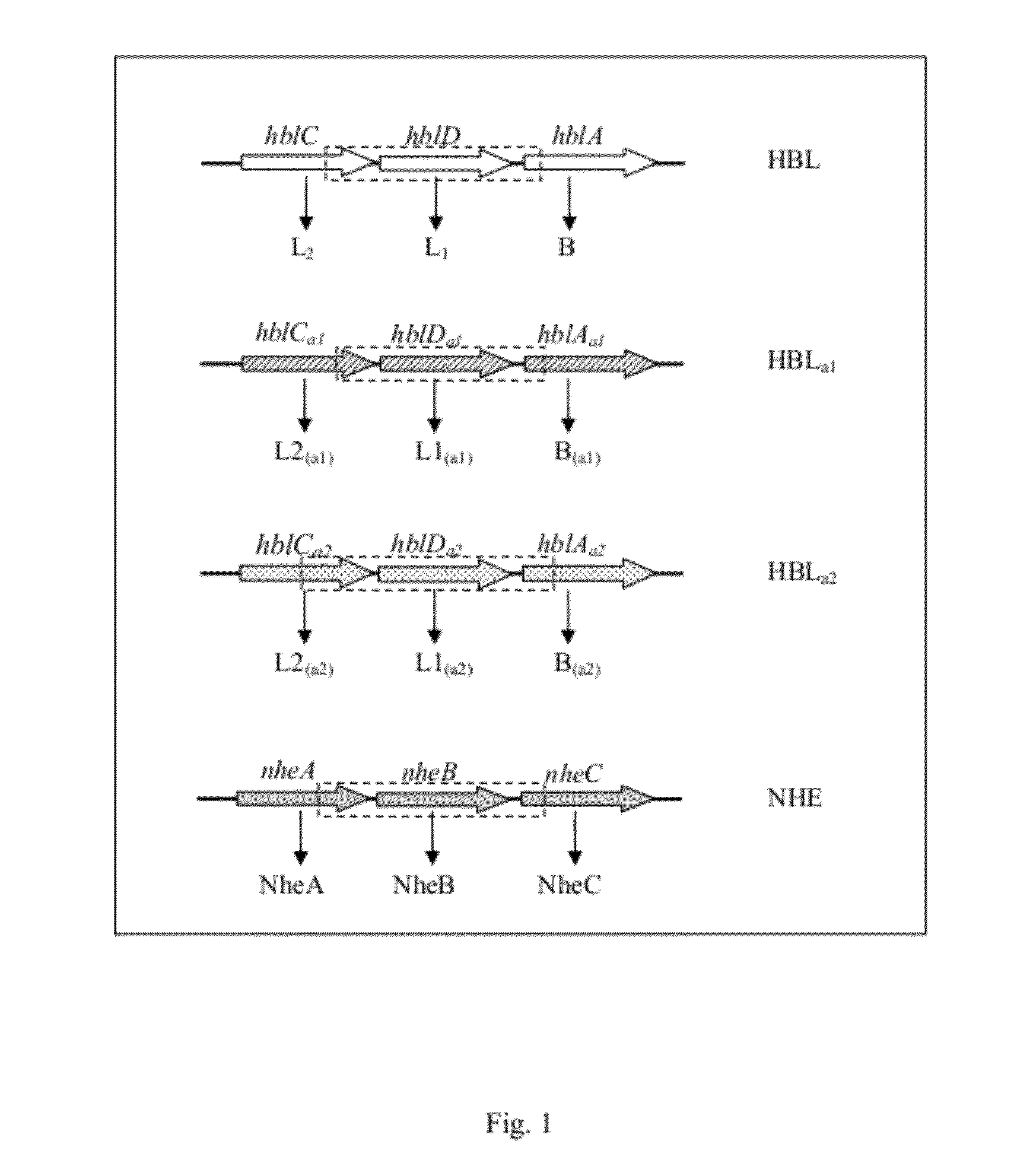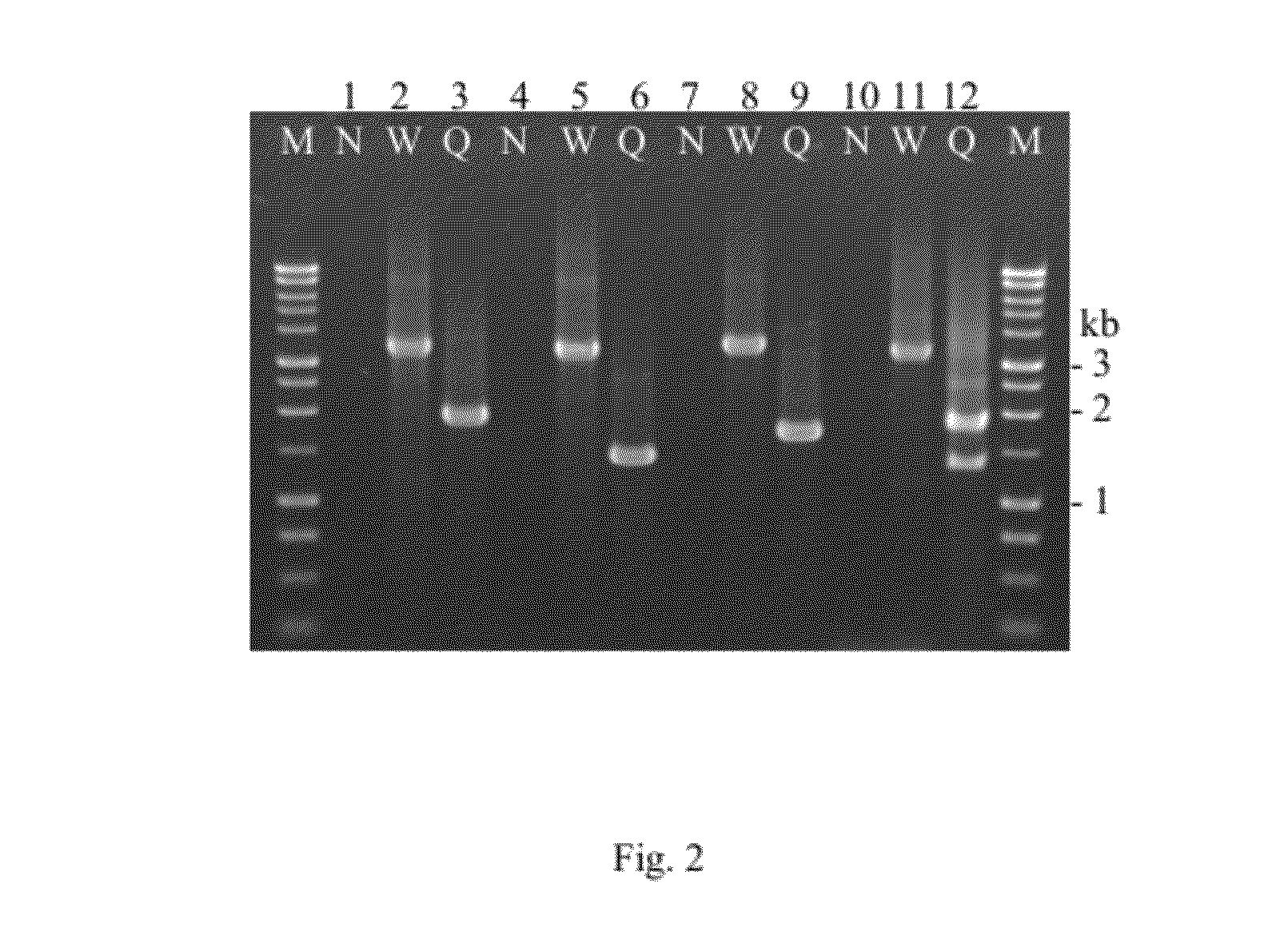Construction of a quadruple enterotoxin-deficient mutant of bacillus thuringiensis
a technology of enterotoxin and mutant, applied in the field of construction of quadruple enterotoxindeficient mutant of bacillus thuringiensis, can solve the problem of residual risk of toxicity
- Summary
- Abstract
- Description
- Claims
- Application Information
AI Technical Summary
Benefits of technology
Problems solved by technology
Method used
Image
Examples
example 1
Materials and Methods
[0035]Bacterial strains, plasmids, and growth conditions. The strains and plasmids used in the present study are listed in Table 1. Escherichia coli was grown in Luria-Bertani (LB) medium at 37° C. B. thuringiensis was grown in either LB or 0.5× Tryptic Soy Broth (TSB) or on 0.5× Tryptic Soy Agar (TSA) at 28° C., 37° C., or 40.5° C. For conjugation, B. thuringiensis was grown in Brain Heart Infusion (BHI) medium. Antibiotics were used at the following concentrations: for E. coli, ampicillin (Amp) at 200 μg / ml, chloramphenicol (Cm) at 10 μg / ml; for B. thuringiensis, erythromycin (Ery) at 3 μg / ml for selection of pMAD or 5 μg / ml for selection of pBKJ236, polymyxin B at 60 μg / ml for conjugations with pBKJ236, and tetracycline (Tet) at 10 μg / ml for selection of pBKJ223.
TABLE 1Bacterial strains and plasmids used in this study.Strain or plasmidDescriptionSource or ReferenceStrainsBacillus thuringiensisWild-typeValent Biosciences Inc.kurstaki strain VBTS 2477(ATCC Acce...
example 2
Materials and Methods
[0054]A quadruple mutant (Δhbla1 Δnhe Δhbl Δhbla2) was created in B. thruingiensis subsp. aizawai strain VBTS 2478.
[0055]Preparation of competent cells of strain B. thuringiensis subsp. aizawai (Bta) strain VBTS 2478. Competent cells of Bta strain VBTS 2478 were prepared using the protocol described for strain VBTS 2477.
[0056]Gene replacement in B. thuringiensis subsp. aizawai (Bta) strain 2478. We determined by PCR analysis that Bta strain VBTS 2478 has the genes that encode HBL, HBLa1, HBLa2, and NHE (data not shown). Bta strain VBTS 2478 was transformed using the protocol described for VBTS 2477. The following constructs were used in construction of the quadruple enterotoxin-deficient mutant of VBTS 2478: pMAD::Δ2477hbl, pMAD::Δ2477hbla1, pMAD::Δ2477hbla2, and pMAD::Δ2477nhe. These constructs were transformed into VBTS 2478 sequentially, and gene replacements were performed iteratively. Transformants were selected on LB agar plates containing 1 μg / ml of Ery a...
example 3
Materials and Methods
[0061]A double mutant (Δhbl Δnhe) was created in B. thuringiensis strain VBTS 2481.
[0062]Preparation of competent cells of B. thuringiensis subsp. israelensis (Bti) strain VBTS 2481. Competent cells of Bti strain VBTS 2481 were prepared using a protocol similar to that described for strain VBTS 2477.
[0063]Gene replacement in B. thuringiensis subsp. israelensis (Bti) strain VBTS 2481. PCR analysis of genomic DNA using degenerate primers specific for hbla1 and hbla2 did not yield any products indicating that VBTS 2481 does not contain hbla1 or hbla2; PCR analysis did confirm that VBTS 2481 contains hbl and nhe (data not shown). Bti strain VBTS 2481 was transformed using a protocol similar to that described for VBTS 2477. The following constructs were used in construction of the double enterotoxin-deficient mutant of VBTS 2481: pMAD::Δ2477hbl, and pMAD::Δ2477nhe. These constructs were transformed into VBTS 2481 sequentially, and gene replacements were performed ite...
PUM
| Property | Measurement | Unit |
|---|---|---|
| concentrations | aaaaa | aaaaa |
| concentrations | aaaaa | aaaaa |
| volume | aaaaa | aaaaa |
Abstract
Description
Claims
Application Information
 Login to View More
Login to View More - R&D
- Intellectual Property
- Life Sciences
- Materials
- Tech Scout
- Unparalleled Data Quality
- Higher Quality Content
- 60% Fewer Hallucinations
Browse by: Latest US Patents, China's latest patents, Technical Efficacy Thesaurus, Application Domain, Technology Topic, Popular Technical Reports.
© 2025 PatSnap. All rights reserved.Legal|Privacy policy|Modern Slavery Act Transparency Statement|Sitemap|About US| Contact US: help@patsnap.com



